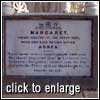
|
Part Seven: Execution by Drowning By Brian Orr Have a question? Click Here to go to Brian's own Discussion Board!
The father of Nanny Nivison, John Nivison, was shot on the Galloway Hills and her brother Thomas had fled to America. But Thomas' ship was wrecked off the Isle of Arran and his return was betrayed to the authorities by a smuggler. When the soldiers came looking for Thomas, Nanny and her grandmother resolutely refused to tell of his whereabouts. The women were stripped and tied to stakes at the flood mark and questioned by an officer on a horse as the tide crept in. The grandmother drowned first, but Nanny it seems remained steadfast and she too died, "not drowned but chilled to death."
Their crime was that they were followers of James Renwick , a Presbyterian preacher. When challenged, both Margarets refused to deny their faith or take an "Abjuration Oath" rejecting a Declaration of Faith that Renwick had recently distributed in the area. Margaret Wilson was the daughter of Gilbert Wilson, a farmer in Glenvernock, Dumfries. The elder Wilson was an Episcopalian but his children, Margaret aged 18, Thomas aged 16 and 13 year-old Agnes refused to adopt the creed of the parents and to take the Abjuration Oath.
While Thomas continued to hide in the hills, the downfall of Margaret and Agnes was to try and find food and warmth in Wigtown. They were, however, recognised, seized and cast into prison in the "Thieves' Hole" amongst the very worst of criminal society. Here they remained for some six or seven weeks, without any privacy, subject to the rigours and privations of the common felons and banned by law from receiving succour and help from their friends. In April, 1685, they were charged with being supporters of the battles at Bothwell Brig and Ayrsmoss and for refusing to take the Abjuration Oath. It is pertinent that only a few weeks prior to their conviction, on April 13th, the Privy Council had ruled that while a man who did not disown James Renwick's Declaration was to be hung, a woman who "had been active in the said courses in a signal manner" was to be drowned in loch or stream or sea.
Agnes was saved from execution by her father travelling to Edinburgh and making a payment of £100 but there was no timely reprieve for Margaret who steadfastly resisted all attempts to get her to recant her faith and the detestable Oath. Despite representations and documents allegedly recanting their deeds and a reprieve granted by the Privy Council on April 30 - which was misdirected to Edinburgh - Margaret Lachlan and Margaret Wilson were led to the sea on May 11, 1685. It is supposition that the execution party led by Robert Grierson of Lag and Major Winram still hoped the women would yield . The women were tied to stakes some distance apart, Margaret Wilson being nearer to the safety of sandbanks. Perhaps they hoped that the sight of the approaching tide taking Margaret Lachlan would make the young girl take the Oath, but it was not to be and both women perished.
Over three hundred years later, in 1992, Margaret Wilson was again at the centre of a dispute, this time over a statue of her tied to a stake. The statue had been donated to the Presbyterian Knox College in Toronto, Canada in 1938 On this occasion the blight and predjudice of political correctness deemed the beautiful marble statue to promote bondage and violence against women. In a knee-jerk reaction the statue was removed from the public rotunda of the college to a private board room. A prolonged battle by the Session at Knox, Waterdown, through the formal channels of the Presbyterian Church to the ultimate authority of the General Assembly finally achieved an order to return the statue to the public area. Even then, dissenters sought to appeal to the following annual General Assembly and a Special Commission was appointed to investigate the matter. After a battle of some four years, the statue was returned to its public space. An interpretative plaque informs the ignorant of the reason for it being there.
Yes, Margaret Wilson was dishevelled after living rough on the moors, then incarcerated for some eight weeks in a 17th century prison, with all help and succour banned by law. Yes, she was bound to a post - for execution by drowning by order of the court and the earlier direction of the highest court of Appeal in the land, the Privy Council. Yes, she was a victim of cruel and brutal men who were responsible for carrying out the court's judgement.
Yes, she was so nearly lost for a second time upon the altar of prejudice. Rest peacefully both Margarets, and all others who suffered in this way; your strength and spirit lies in the safe-keeping of the common people of the kirk who understand and revere your sacrifice. A Postscript It is strange that the story of Margaret Wilson should again come to the fore with an article in the Liverpool Daily Post on February 24, 2000, reporting on a painting of her by Sir John Everett Millais, called the " Martyr of the Solway " .
The story also ran in the "Daily Telegraph" (London, England) and Canada's "National Post" where it was seen by a member of the Knox congregation who knew of their own local difficulty over Margaret's statue.
Meet the Author, Brian Orr, Researcher with The Guild of One Name Studies
Back to The Covenanters, Main Page
Part One: The Covenanters: Who Were They?
Covenanters Time Line
|
Thursday, December 26th, 2019
Attention visitors: Tartans.com is back. Please note that this is a snapshot of the site as it existed nearly 20 years ago and you may encounter broken links; we are still combing through the site and correcting those as we find them. Please also note that some sections are currently not functional, primarily the discussion forums/clan chat boards.
|
** HOME - First Time Visitors - Glossary - - Contact Us ** Awards | Bibliography | Clan Calendar | Clan Chat | Clan Finder | History | Famous Scots | Genealogy | Great Hall of the Clans | Links | News and Features | Scots on the Net | Search | Site Map The Gathering of the Clans
Copyright 1995- Tartans.com - All Rights Reserved. |







